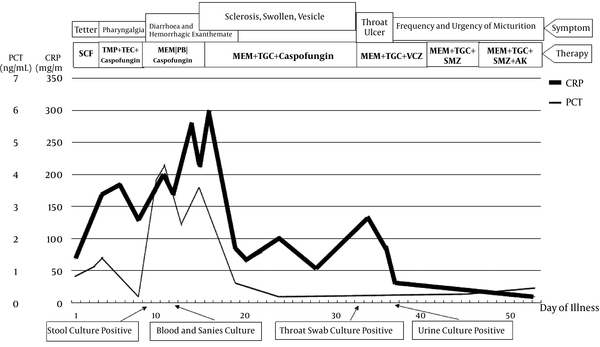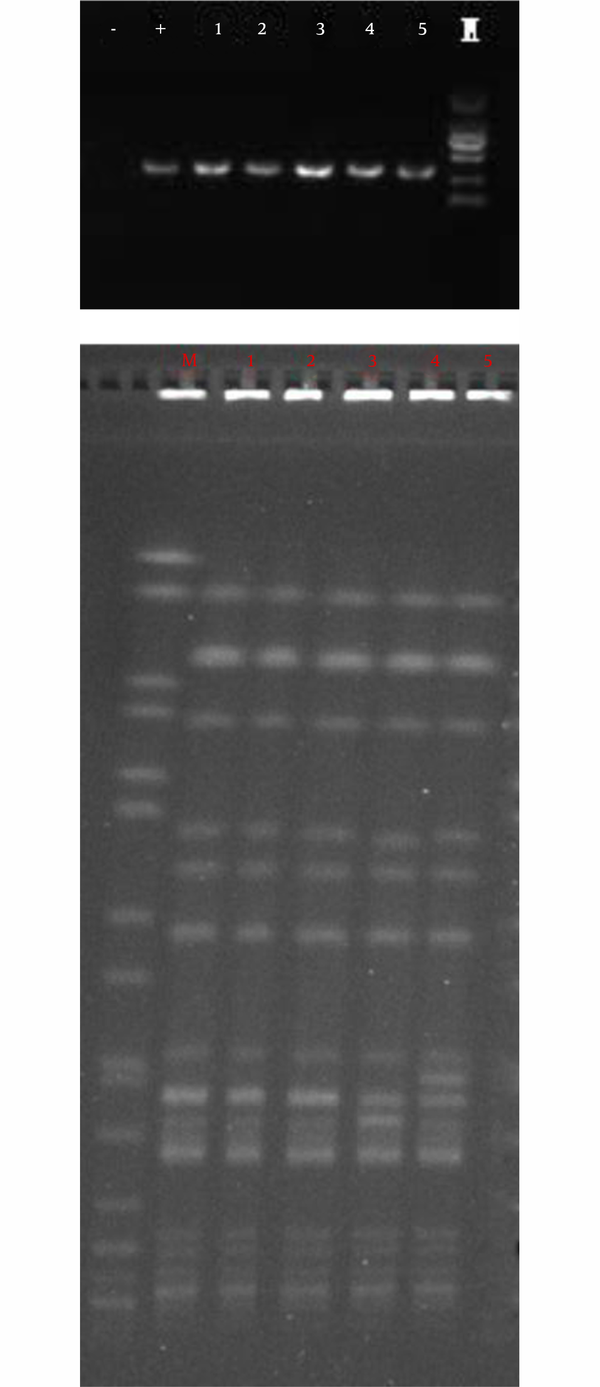Abstract
Introduction:
Leukemia patients can easily become hypoimmunity after hemopoietic stem cell transplantation, endogenous infection often happens in these patients. Meanwhile, Klebsiella pneumoniae is often isolated from various specimens in inpatient. It can lead to infections in the whole body, especially in those immunosuppressed patients.Case Presentation:
A 22-year-old girl with complete remission after chemotherapy for her acute lymphoblastic leukemia was presented to the 2nd affiliated hospital of Zhejiang University for hemopoietic stem cell transplantation. She got a good check-up, however, her spirit was a little bad. Her primitive lymphocyte (0.06%) and total lymphocyte (27.05%) in the peripheral blood were in the normal range. She received a 224 mL stem cell transfusion including mononuclear cell (4.87 × 108/kg) CD34+ (0.6%) as well as reached the transplantation threshold of CD34+ cell (3 × 106/kg). Nine days after transplantation, there were no severe side effects except a little bit of vomit. However, the symptom of diarrhea appeared first. K. pneumoniae was isolated from the stool, then invaded into the blood, and caused sepsis. It disseminated and caused multi-sites infection.Conclusions:
It should be kept in mind that K. pneumoniae can translocate across the intestinal epithelium. It is important to pay attention to the bacterium isolated from the intestine in immunosuppressed patients.Keywords
Multi-Sites Infection Immunosuppressed Patient Intestine Klebsiella Pneumoniae
1. Introduction
Klebsiella pneumoniae is one of the most common pathogens (1, 2) and is often isolated from various specimens in the inpatient (3), especially in those immunosuppressed patients, such as cancer patients (4). However, the report of K. pneumoniae in the intestine invading into the blood is rare. Here we report a case of multi-site infections caused by K. pneumoniae after hemopoietic stem cell transplantation, which was first isolated from the stool, then the blood, the sanies, the throat swab, and the urine.
2. Case Presentation
A 22-year-old girl with complete remission after chemotherapy for her acute lymphoblastic leukemia was referred to our hospital for hemopoietic stem cell transplantation on March 22, 2016. On the presentation, her temperature was 36.8°C, blood pressure was 125/93 mmHg and her heart rate as well as respiration were 93/min and 19/min, respectively. She received a good check-up, although, she wasn't in good spirit. Her primitive lymphocyte (0.06%) and total lymphocyte (27.05%) in the peripheral blood were in the normal range. Sulfamethoxazole was used to clean her intestine. BuCy and Flu were used to pretreat the bone marrow before receiving hemopoietic stem cell transplantation on April 5, 2016. Ciclosporin and mycophenolate mofetil were used for preventing a reject reaction.
She received a 224 mL stem cell transfusion, including a mononuclear cell (4.87 × 108/kg), CD34+ (0.6%), as well as reached the transplantation threshold of CD34+ cell (3 × 106/kg). Nine days after transplantation, there were no severe side effects except a little bit of vomit. However, diarrhea and hemorrhagic exanthemate of both knees appeared April 15, 2016 and a 3 cm × 2 cm sclerosis appeared on the right greater lip of pudendum. The right greater and lesser lip of pudendum were swollen 1 day later on April 16, 2016. The inspection results, clinical symptoms, and prescriptions were collected (Figure 1). The isolates were collected from the stool culture on April 15, 2016, the blood culture as well as sanies culture on April 18, 2016, the throat swab culture on May 9, 2016, and the urine culture on May 13, 2016 were all the same bacterium (K. pneumoniae).
Clinical Course of the Patient After Hospitalization

The antibiotics susceptibility against 5 K. pneumoniae strains were the same (Table 1). The K. pneumoniae was resistant to all antibiotics that we tested except polymyxin B and tigecycline, as it was called carbapenem-resistant K. pneumonia. In addition we detected the resistant genes of carbapenem by PCR (5) and DNA sequence. They were all positive for the blaKPC gene (Figure 2A) and negative for blaSME, blaVIM, blaIMP, blaNDM, blaGIM, blaSPM, blaSIM, and blaOXA genes (data not shown). The resistant gene was blaKPC-2 by sequencing. Pulsed field gel electrophoresis (PFGE) (6) demonstrated that the 5 K. pneumoniae isolates belonged to the same clone (Figure 2B).
Minimum Inhibitory Concentration of Antibiotics
| Antibiotics | MIC, μg/mL |
|---|---|
| Ampicillin | ≥ 32 |
| Cefazolin | ≥ 64 |
| Gentamicin | ≥ 16 |
| Tobramycin | ≥ 16 |
| Cefepime | ≥ 64 |
| Ceftriaxone | ≥ 64 |
| Cefoxitin | ≥ 64 |
| Imipenem | ≥ 16 |
| Ertapenem | ≥ 8 |
| Amikacin | ≥ 64 |
| Ciprofloxacin | ≥ 4 |
| Levofloxacin | ≥ 8 |
| Trimethoprim/sulfamethoxazole | ≥ 16/304 |
| Amoxicillin/clavulanate | ≥ 32/16 |
| Piperacillin/tazobactam | ≥ 128/4 |
| Tigecycline | 2 |
| Aztreonam | ≥ 64 |
| Polymyxin B | 0.5 |
A, PCR of blaKPC Gene of Five K. pneumoniae Isolates. Lane -: Negative Control, Lane +: Positive Control, Lane M: Marker DL 2000; B, PFGE of Five K. pneumoniae Isolates. Lane M: Salmonella Serotype Braenderup H9812. Lane 1 ~ 5: K. pneumoniae Isolated from Stool, Blood, Sanies, Throat Swab, and Urine

3. Discussion
As we all know, K. pneumoniae is one of the most common and clinically important pathogens worldwide, causing abscess (especially liver abscess) (7, 8), and then invades into blood causing multi-sites infection. It can also cause an endogenous infection in diabetes mellitus patients (9-11) as well as cancer patients (12). However, the report of K. pneumoniae in the intestine invading into blood is rare. This is the first time to report a K. pneumoniae isolate invading into the blood from the intestine in a patient who was receiving hemopoietic stem cell transplantation and then causes multi-sites infection. As we know, due to immunosuppress, leukemia patients often received an opportunistic infection through a different pathway. Like the EB virus and Aspergillus infection through respiratory tract (13, 14), urinary tract infection caused by Escherichia coli (15) and derma infection is caused by Herpes Zoster (16). However, infection caused by intestinal microbiology is rare, just a report of intestinal dysbacteriosis (17). As Chun-Ru Hsu et al. (18) reported K. pneumoniae can translocate across the intestinal epithelium; the gut is always the epicentre of antibiotics resistance (19). Therefore, we need to pay attention to the bacteria isolated from the intestine in the immunosuppressed patients.
References
-
1.
Sewify M, Nair S, Warsame S, Murad M, Alhubail A, Behbehani K, et al. Prevalence of Urinary Tract Infection and Antimicrobial Susceptibility among Diabetic Patients with Controlled and Uncontrolled Glycemia in Kuwait. J Diabetes Res. 2016;2016:6573215. [PubMed ID: 26844231]. https://doi.org/10.1155/2016/6573215.
-
2.
Chuang C, Fan WC, Lin YT, Wang FD. The emergence of Klebsiella pneumoniae liver abscess in non-diabetic patients and the distribution of capsular types. Gut Pathog. 2016;8:46. [PubMed ID: 27777630]. https://doi.org/10.1186/s13099-016-0128-y.
-
3.
Calbo E, Garau J. The changing epidemiology of hospital outbreaks due to ESBL-producing Klebsiella pneumoniae: the CTX-M-15 type consolidation. Future Microbiol. 2015;10(6):1063-75. [PubMed ID: 26059626]. https://doi.org/10.2217/fmb.15.22.
-
4.
Freire MP, Pierrotti LC, Filho HH, Ibrahim KY, Magri AS, Bonazzi PR, et al. Infection with Klebsiella pneumoniae carbapenemase (KPC)-producing Klebsiella pneumoniae in cancer patients. Eur J Clin Microbiol Infect Dis. 2015;34(2):277-86. [PubMed ID: 25169967]. https://doi.org/10.1007/s10096-014-2233-5.
-
5.
Iraz M, Ozad Duzgun A, Sandalli C, Doymaz MZ, Akkoyunlu Y, Saral A, et al. Distribution of beta-lactamase genes among carbapenem-resistant Klebsiella pneumoniae strains isolated from patients in Turkey. Ann Lab Med. 2015;35(6):595-601. [PubMed ID: 26354347]. https://doi.org/10.3343/alm.2015.35.6.595.
-
6.
Gouby A, Neuwirth C, Bourg G, Bouziges N, Carles-Nurit MJ, Despaux E, et al. Epidemiological study by pulsed-field gel electrophoresis of an outbreak of extended-spectrum beta-lactamase-producing Klebsiella pneumoniae in a geriatric hospital. J Clin Microbiol. 1994;32(2):301-5. [PubMed ID: 8150938].
-
7.
Ma LC, Fang CT, Lee CZ, Shun CT, Wang JT. Genomic heterogeneity in Klebsiella pneumoniae strains is associated with primary pyogenic liver abscess and metastatic infection. J Infect Dis. 2005;192(1):117-28. [PubMed ID: 15942901]. https://doi.org/10.1086/430619.
-
8.
Fung CP, Siu LK. Virulence of Klebsiella pneumoniae serotype K2 should not be underestimated in K. pneumoniae liver abscess. Clin Infect Dis. 2007;45(11):1530-1. author reply 1532-3. [PubMed ID: 17990243]. https://doi.org/10.1086/523007.
-
9.
Nagai T, Inoue C, Tonouchi K, Tonooka N, Imamura M, Kaneko K, et al. Multiple organ failure followed by intrauterine klebsiella pneumoniae infection associated with diabetes mellitus. Kitakanto Med J. 2009;59(2):151-5. https://doi.org/10.2974/kmj.59.151.
-
10.
Liao HR, Lee HW, Leu HS, Lin BJ, Juang CJ. Endogenous Klebsiella pneumoniae endophthalmitis in diabetic patients. Can J Ophthalmol. 1992;27(3):143-7. [PubMed ID: 1586886].
-
11.
Sawada A, Komori S, Udo K, Suemori S, Mochizuki K, Yasuda M, et al. Case of endogenous endophthalmitis caused by Klebsiella pneumoniae with magA and rmpA genes in an immunocompetent patient. J Infect Chemother. 2013;19(2):326-9. [PubMed ID: 22992835]. https://doi.org/10.1007/s10156-012-0468-6.
-
12.
Lin YT, Liu CJ, Fung CP, Tzeng CH. Nosocomial Klebsiella pneumoniae bacteraemia in adult cancer patients--characteristics of neutropenic and non-neutropenic patients. Scand J Infect Dis. 2011;43(8):603-8. [PubMed ID: 21539500]. https://doi.org/10.3109/00365548.2011.577800.
-
13.
Mori N, Yamashita Y, Tsuzuki T, Nakayama A, Nakazawa M, Hasegawa Y, et al. Lymphomatous features of aggressive NK cell leukaemia/lymphoma with massive necrosis, haemophagocytosis and EB virus infection. Histopathology. 2000;37(4):363-71. [PubMed ID: 11012744]. https://doi.org/10.1046/j.1365-2559.2000.00936.x.
-
14.
van Burik JA, Carter SL, Freifeld AG, High KP, Godder KT, Papanicolaou GA, et al. Higher risk of cytomegalovirus and aspergillus infections in recipients of T cell-depleted unrelated bone marrow: analysis of infectious complications in patients treated with T cell depletion versus immunosuppressive therapy to prevent graft-versus-host disease. Biol Blood Marrow Transplant. 2007;13(12):1487-98. [PubMed ID: 18022579]. https://doi.org/10.1016/j.bbmt.2007.08.049.
-
15.
Hari MD, Soetaryo PAK. The risk factor of urinarytract infection in patient with leukemia. Berkala Ilmu Kedokteran. 2009;41(4):178-82.
-
16.
Demircioglu S, Aydogdu İ, Kaya E, Kuku İ, Erkurt MA. Atypical presentation of herpes zoster infection following fludarabine treatment for chronic Lymphocytic leukemia: A case report. J Inonu Univ Med Faculty. 2011;18(4):281-3.
-
17.
Tomoda T, Nakano Y, Kageyama T. Intestinal candida overgrowth and candida infection in patients with leukemia: Effect of bifidobacterium administration. Bifidobacteria Microflora. 1988;7(2):71-4. https://doi.org/10.12938/bifidus1982.7.2_71.
-
18.
Hsu CR, Pan YJ, Liu JY, Chen CT, Lin TL, Wang JT. Klebsiella pneumoniae translocates across the intestinal epithelium via Rho GTPase- and phosphatidylinositol 3-kinase/Akt-dependent cell invasion. Infect Immun. 2015;83(2):769-79. [PubMed ID: 25452552]. https://doi.org/10.1128/IAI.02345-14.
-
19.
Carlet J. The gut is the epicentre of antibiotic resistance. Antimicrob Resist Infect Control. 2012;1(1):39. [PubMed ID: 23181506]. https://doi.org/10.1186/2047-2994-1-39.